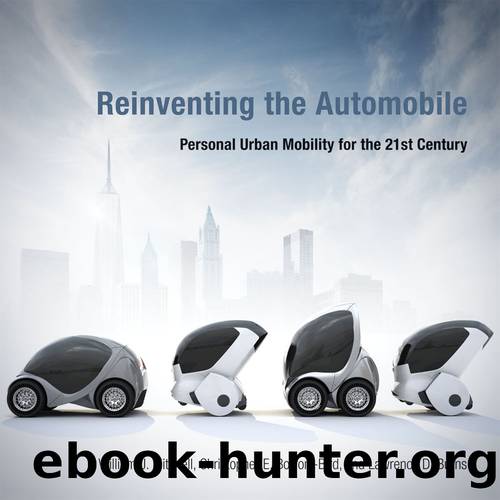Reinventing the Automobile by Mitchell William J. Borroni-Bird Chris. Burns Lawrence D

Author:Mitchell, William J.,Borroni-Bird, Chris.,Burns, Lawrence D. [Mitchell, William J.]
Language: eng
Format: epub
ISBN: 9780262288569
Publisher: MIT Press
Published: 2010-07-15T00:00:00+00:00
Figure 6.6
Inductive charging walkways can be overlaid on the slabs of existing parking structures.
Potential Electrification of Roadways
In the long term, it might be possible to extend the electric supply infrastructure even further by providing charging strips or studs at appropriate locations in roadway surfaces. The most attractive locations for this would be high-investment, heavily traveled, tightly controlled roadways, such as the bridges and tunnels leading into Manhattan, and the extensive tunnels of Bostonâs Big Dig.
Technological feasibility has been demonstrated in some recent electric tramway systems, particularly in the APS (Alimentation par Sol) system used by trams in Bordeaux since 2003.7 This system employs a rail in the road surface, divided electrically into eight-meter segments with three-meter neutral segments in between. For pedestrian safety, it senses when a tram is above a segment, switches it on, and then switches it off when the tram moves away from the segment. For transfer from these energized rail segments, trams employ collection skates mounted close to the road surface. This arrangement is unlikely to supply electricity at a fast enough rate, in the times that vehicles would be in contact with it, to provide full battery recharges. But it might extend range by reducing drain on batteries and providing top-off.
In 2009, KAIST (Korea Advanced Institute of Science and Technology) demonstrated prototype electric vehicles that were powered inductively from coil lines in the road surface (figure 6.7). However, it remains to be seen whether roadway charging systems can be made economical for many smaller vehicles, rather than relatively few large vehicles as with trams. Automobiles charged in this way require shorter charging segments than trams, and they are likely to be less precisely positioned. However, combination of charging strips with electronic guidance may resolve this difficulty.
Download
This site does not store any files on its server. We only index and link to content provided by other sites. Please contact the content providers to delete copyright contents if any and email us, we'll remove relevant links or contents immediately.
Life 3.0: Being Human in the Age of Artificial Intelligence by Tegmark Max(5516)
The Sports Rules Book by Human Kinetics(4342)
The Age of Surveillance Capitalism by Shoshana Zuboff(4245)
ACT Math For Dummies by Zegarelli Mark(4022)
Unlabel: Selling You Without Selling Out by Marc Ecko(3625)
Blood, Sweat, and Pixels by Jason Schreier(3584)
Hidden Persuasion: 33 psychological influence techniques in advertising by Marc Andrews & Matthijs van Leeuwen & Rick van Baaren(3519)
Bad Pharma by Ben Goldacre(3396)
The Pixar Touch by David A. Price(3389)
Urban Outlaw by Magnus Walker(3366)
Project Animal Farm: An Accidental Journey into the Secret World of Farming and the Truth About Our Food by Sonia Faruqi(3189)
Kitchen confidential by Anthony Bourdain(3049)
Brotopia by Emily Chang(3026)
Slugfest by Reed Tucker(2973)
The Content Trap by Bharat Anand(2887)
The Airbnb Story by Leigh Gallagher(2821)
Coffee for One by KJ Fallon(2601)
Smuggler's Cove: Exotic Cocktails, Rum, and the Cult of Tiki by Martin Cate & Rebecca Cate(2497)
Beer is proof God loves us by Charles W. Bamforth(2417)
